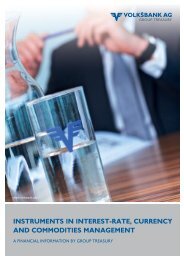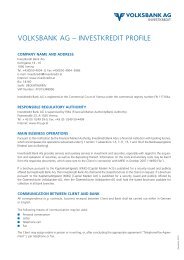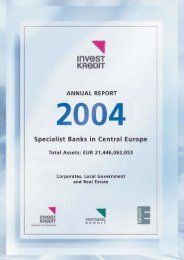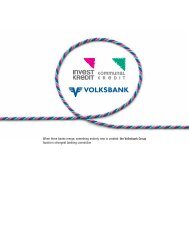Download - Volksbank AG
Download - Volksbank AG
Download - Volksbank AG
Create successful ePaper yourself
Turn your PDF publications into a flip-book with our unique Google optimized e-Paper software.
THE BANK FOR CORPORATES<br />
72<br />
Glossary<br />
Hedging. Procedure under which an existing risk item is neutralized by a countervailing transaction.<br />
Held to maturity. Category of securities that are assigned to fixed assets and are held until they fall due.<br />
IAS. International Accounting Standards: accounting rules in the development of which international associations of accountants<br />
and experts cooperate under the leadership of the International Accounting Standards Committee. The purpose is comparable<br />
worldwide accounting and publicity and the processing of relevant information for a broad public, in particular, investors. The rules<br />
include not only general accounting principles but also, currently, 40 standards, and are becoming accepted as an EU-wide system for<br />
financial statements.<br />
Index-linked notes. Bonds, the interest on which is tied to a stock exchange index.<br />
Interest-rate risk. Risk of a reduction in revenue or an increase in costs and a loss of value resulting from a change in interest rates.<br />
Interest-rate swap. Agreement between two contracting partners to exchange interest payments in one and the same country or<br />
currency over a particular period of time (not an exchange of capital).<br />
Internal rating. Rating of a corporate by the bank, see also Rating.<br />
Investment grade. AAA (S&P) / Aaa (Moody’s) to BBB- (S&P) / Baa3 (Moody’s) ratings. The default risk is low in this range.<br />
Investments accounted for under the equity method. Significant but not controlled equity investments are recognized in the<br />
consolidated balance sheet at the share of own funds. The share of profits or losses for the year is entered in the consolidated income<br />
statement.<br />
Liability concept. Under the balance-sheet-oriented liability method, deferred taxes are regarded as liabilities to or claims against<br />
the tax authorities.<br />
Macrohedge. Protection of a portfolio of financial instruments that as a rule contains several derivatives.<br />
Market-to-market valuation. Valuation of financial instruments at current fair prices, independently of acquisition costs and<br />
including unrealized price gains.<br />
Market capitalization. Value of all shares as at year-end.<br />
Market risk. Danger of a loss in value arising through unexpected changes in fair prices (interest, share prices, exchange rates, prices<br />
of goods), before the items affected can be closed or protected.<br />
MBI. Management Buy-In. Acquisition of a business by an external management with the support of a financing bank and usually of<br />
a financing investor.<br />
MBO. Management Buy-Out. Acquisition of a corporate by the management with the support of a financing bank and usually of a<br />
financial investor.<br />
Mergers and acquisitions (M&A). Combinations or purchases and sales of corporates.<br />
Mezzanine financing. Chiefly, subordinated financing that takes on functions similar to equity capital. Mezzanine capital occupies<br />
a position between equity and borrowing in the financing structure.<br />
Microhedge. Protection of a financial instrument by a derivative.<br />
Migration probability. The probability that an corporate’s rating will deteriorate, improve or remain stable over a year.<br />
Minimum capital requirements. Banks must have equity capital backing for at least 8% of their risk-weighted assets.<br />
Money market. A market for the short-term investment or borrowing of money, see also Capital market.<br />
Net trading result. Balance of earnings and expenses from a bank’s own trading in securities, financial instruments (in particular,<br />
derivatives), foreign currency and precious metals that are valued at fair prices (market-to-market valuation). This item also includes<br />
that part of current interest, dividends and refinancing components that is to be attributed to trading activities.<br />
New Basel Capital Accord. Comprehensive approach to the minimum capital requirements of banks, prepared by the Basel Committee<br />
on Banking Supervision, first published as a consultation paper in 1999. The 600-page second version is divided into seven technical<br />
documents, see also: Basel II.<br />
Non-investment grade. BB+ (S&P) / Ba1 (Moody’s) to D ratings. Investments in this range (e.g. high-yield bonds or junk bonds) carry<br />
a higher default risk.<br />
Online banking. Transaction of banking business via electronic networks (Internet) also known as electronic banking.<br />
Operational risk. The risk of direct or indirect losses resulting from the failure or inadequacy of internal procedures, human error,<br />
system failure or external events.<br />
Option. The right to purchase (purchase option/call) a particular item (for example, securities or currency) from a contracting party<br />
or to sell such item to him (selling auction/put) at a previously agreed price, at a particular time and over a particular period of time.<br />
OTC derivatives. Financial instruments (derivatives) that are not standardized and are not listed on a stock exchange but are traded<br />
directly between market participants – over the counter.









